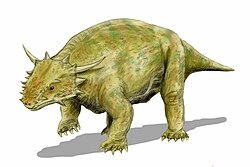| Coartaredens isaaci Temporal range: Middle Triassic, | |
|---|---|
| Scientific classification | |
| Kingdom: | Animalia |
| Phylum: | Chordata |
| Class: | Reptilia |
| Genus: | † Coartaredens Spencer & Storrs, 2002 |
| Species: | †C. isaaci |
| Binomial name | |
| †Coartaredens isaaci Spencer & Storrs, 2002 | |
Coartaredens is an extinct genus of reptile from the Middle Triassic of England. It contains a single species, Coartaredens isaaci, from the Anisian-age Otter Sandstone of Devon. The species is based on a partial jaw and other fragments with large conical teeth. Though originally described as a lepidosauromorph, [1] [2] some authors have instead considered it to be a procolophonid. [3]

